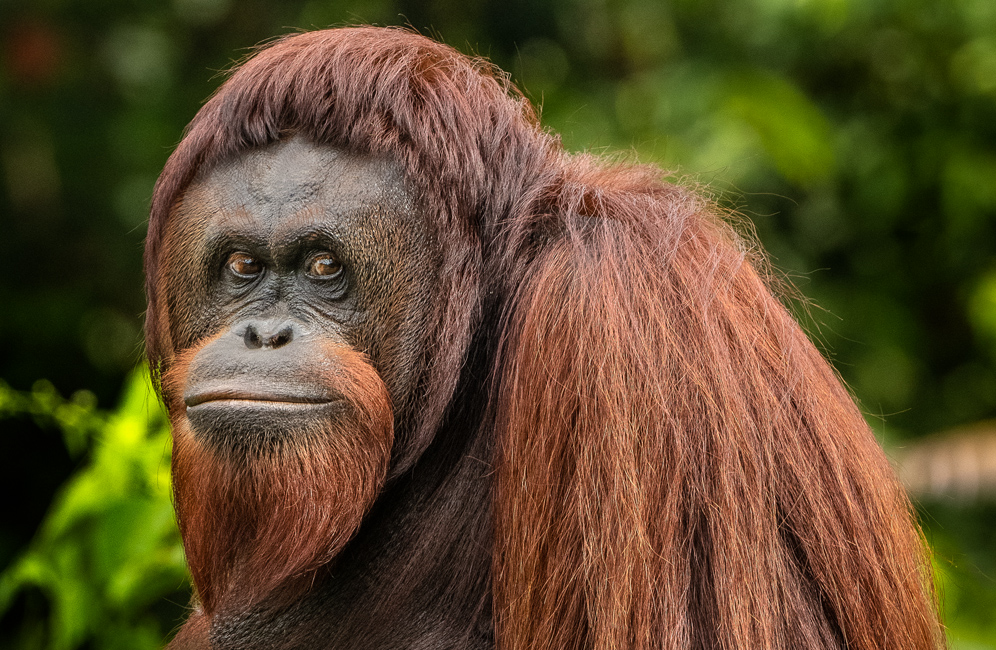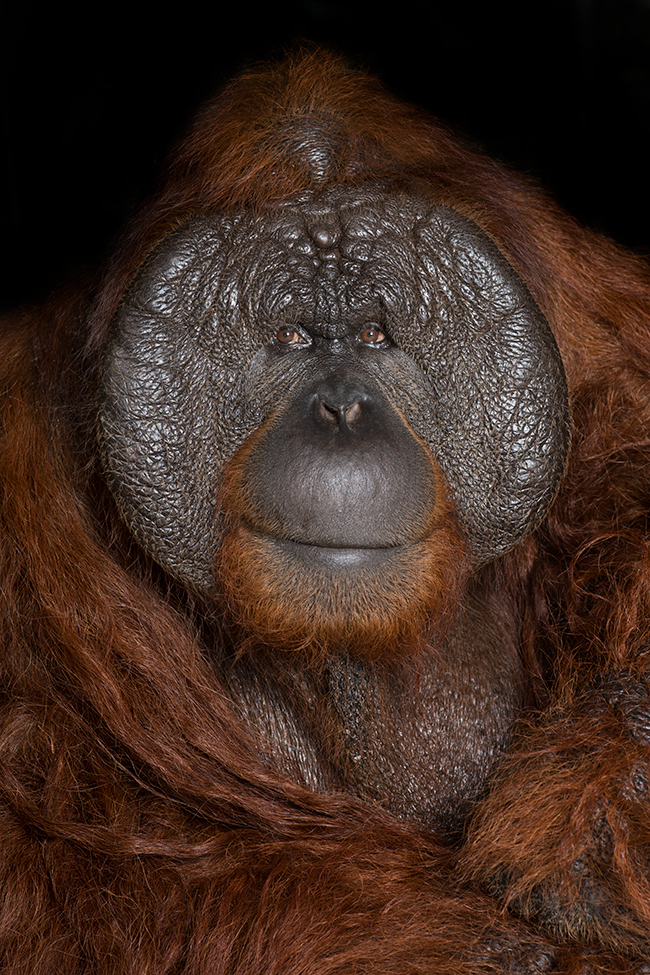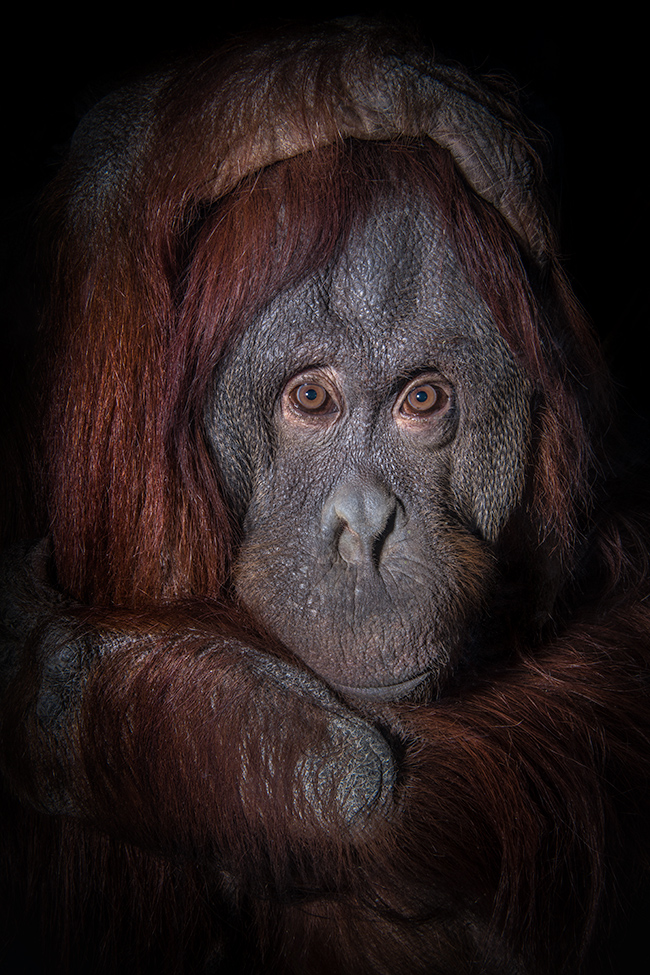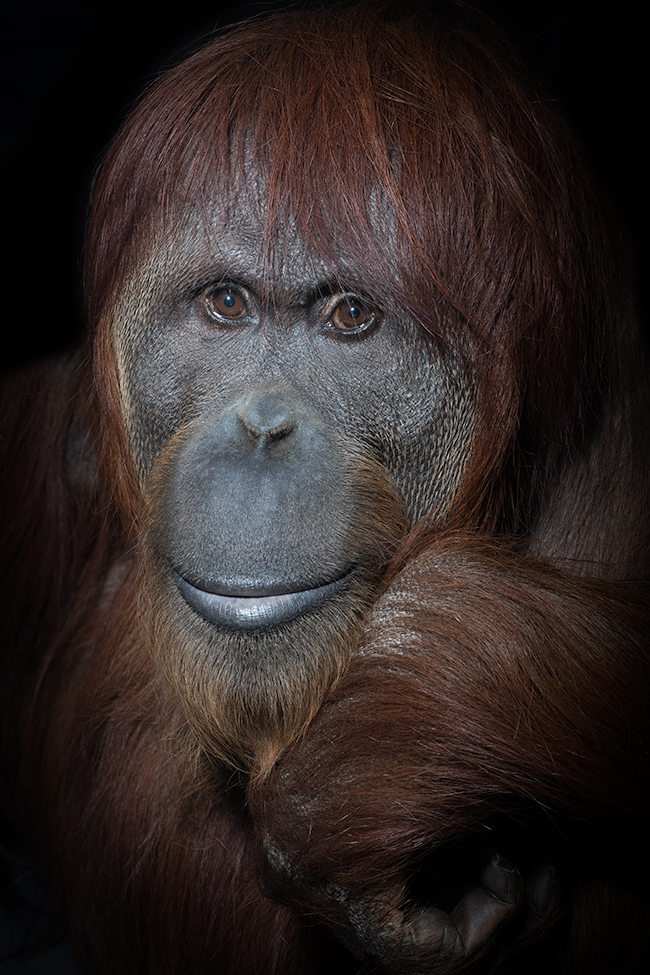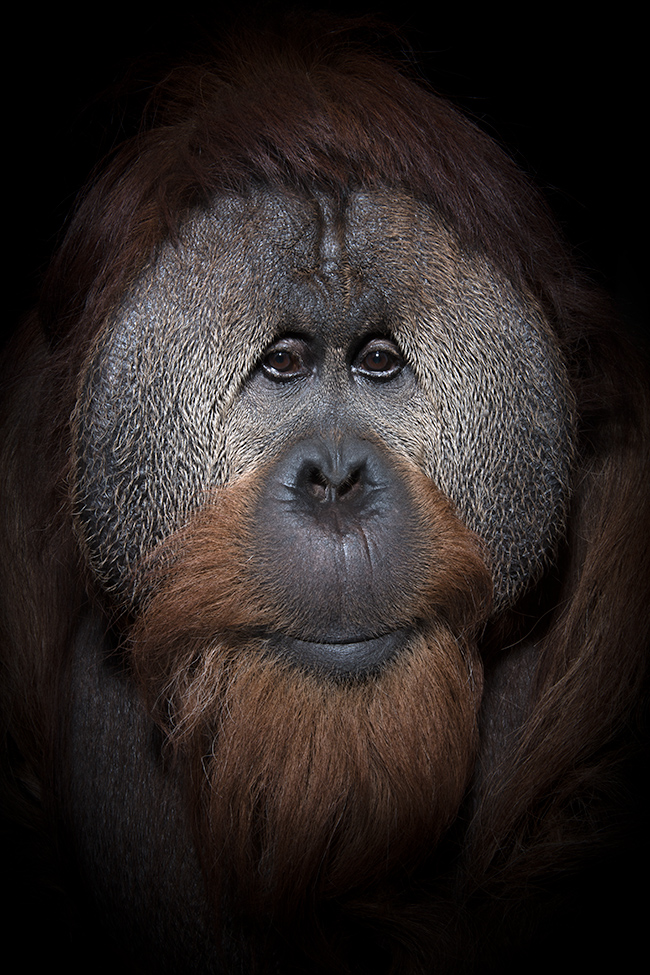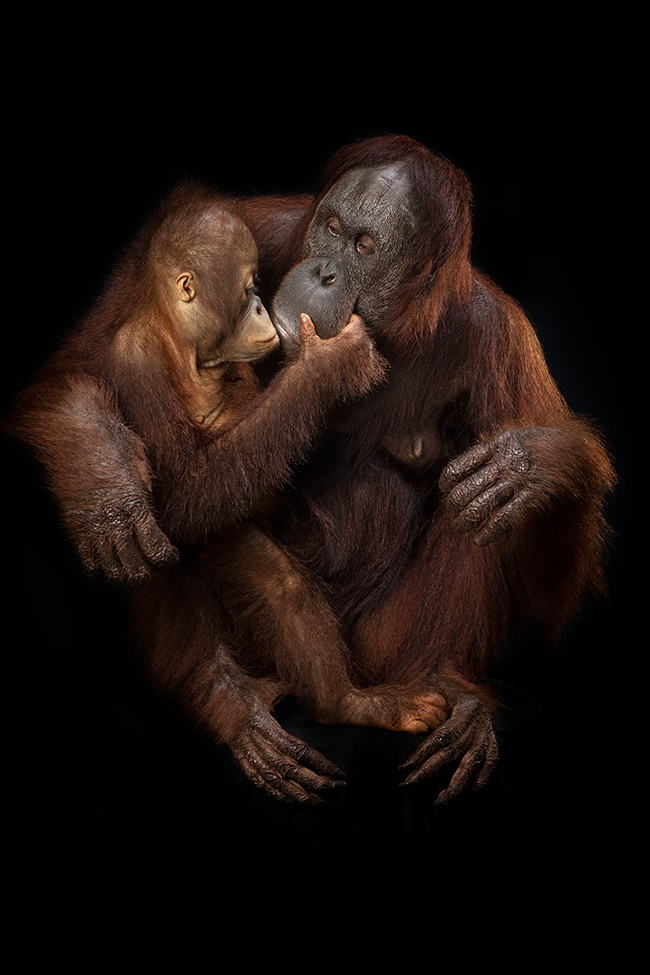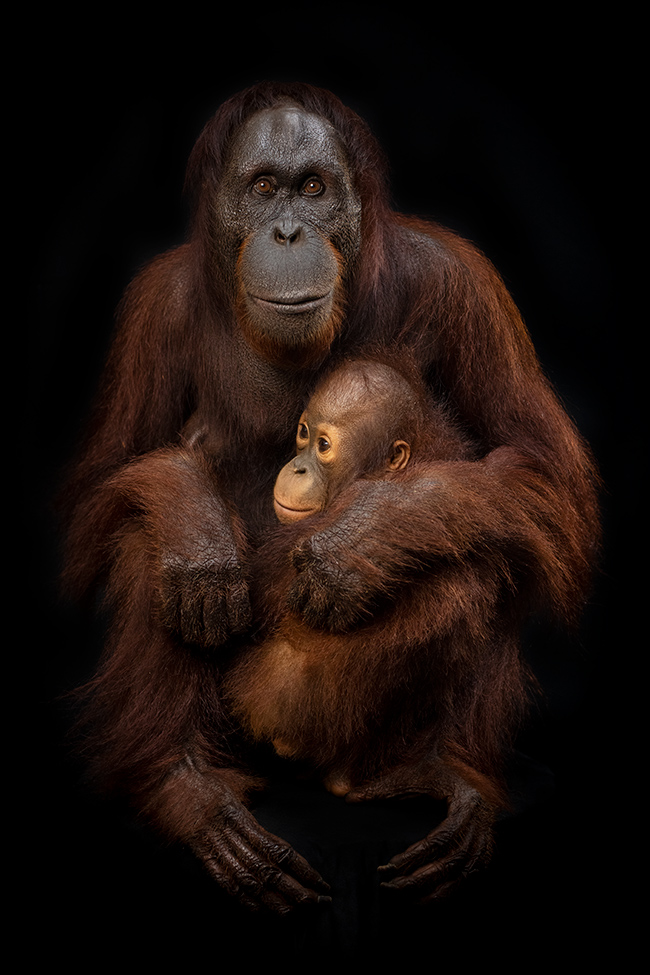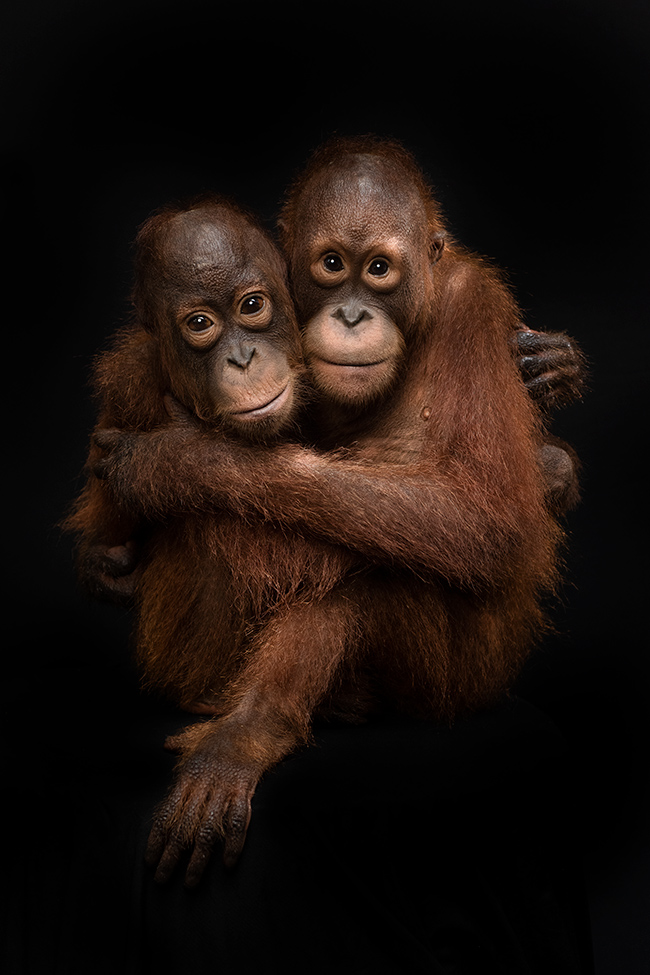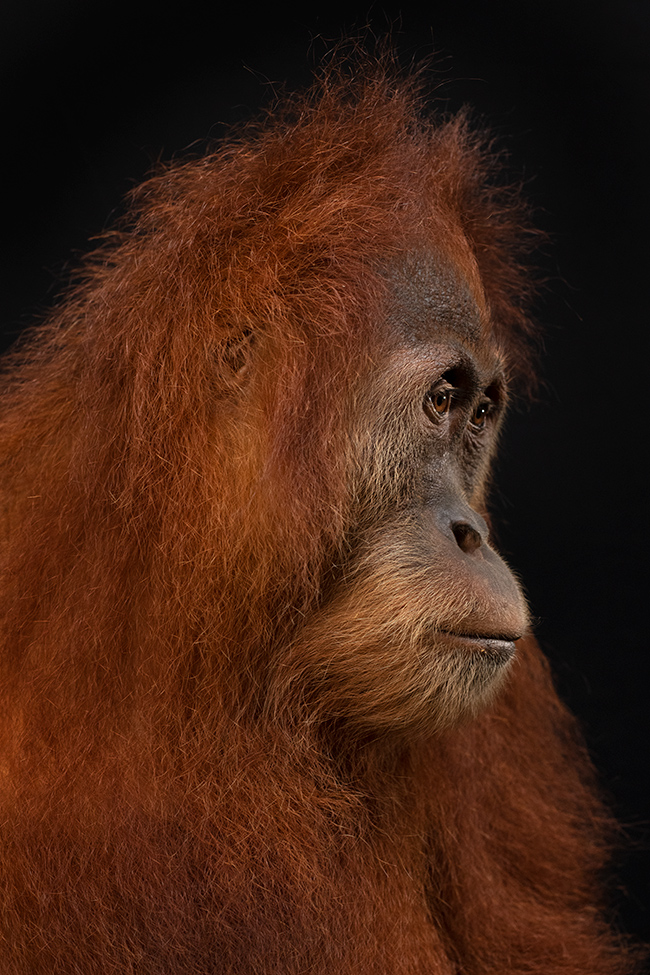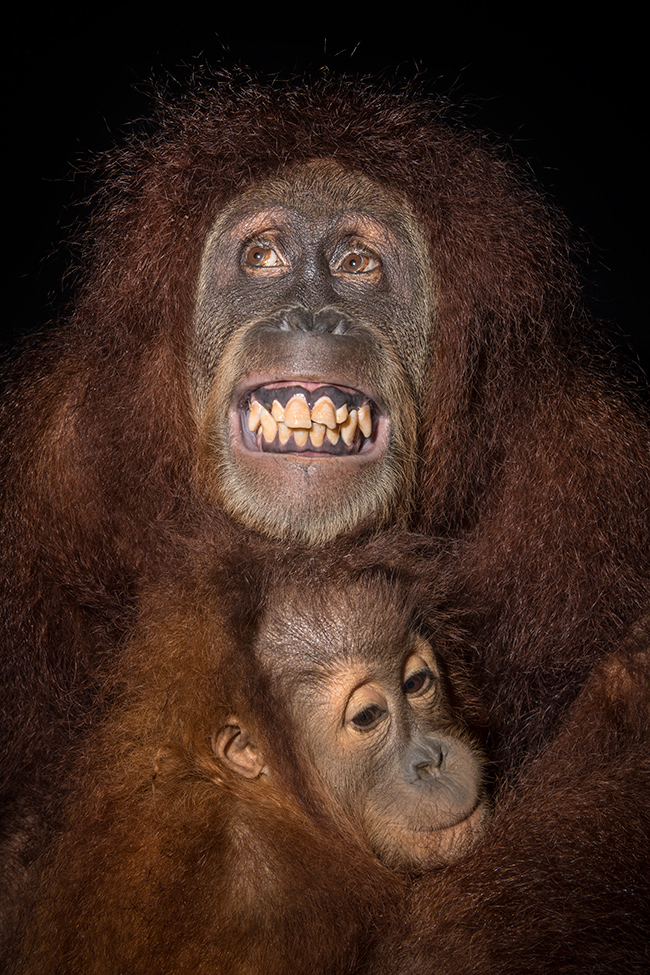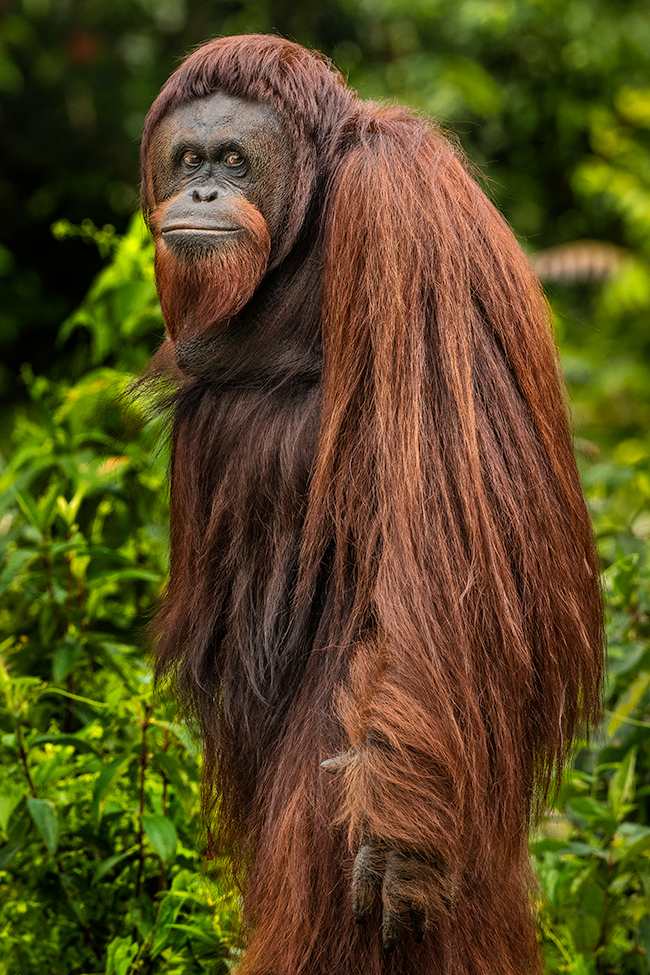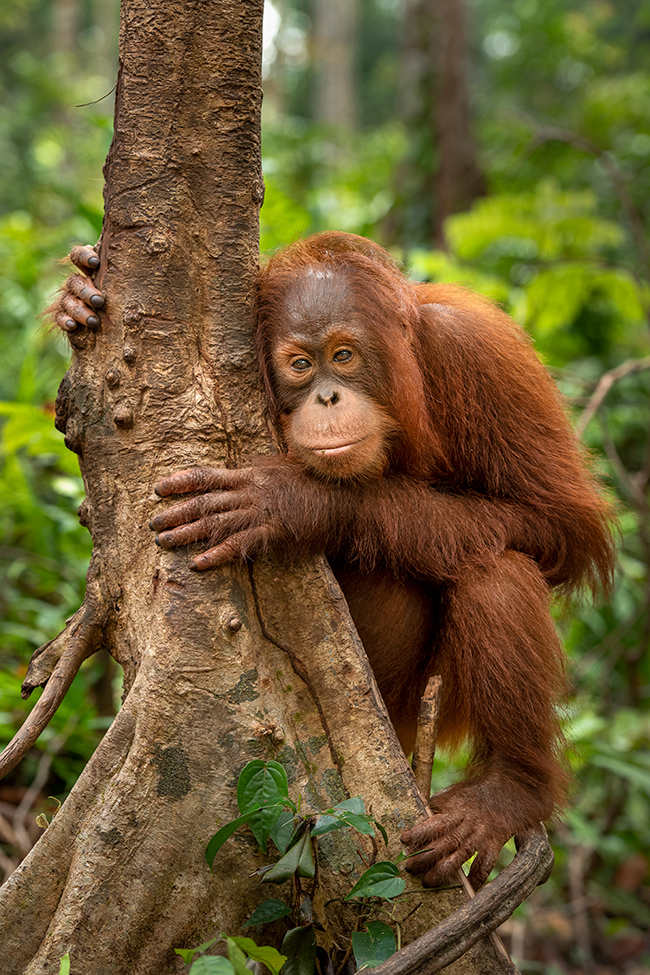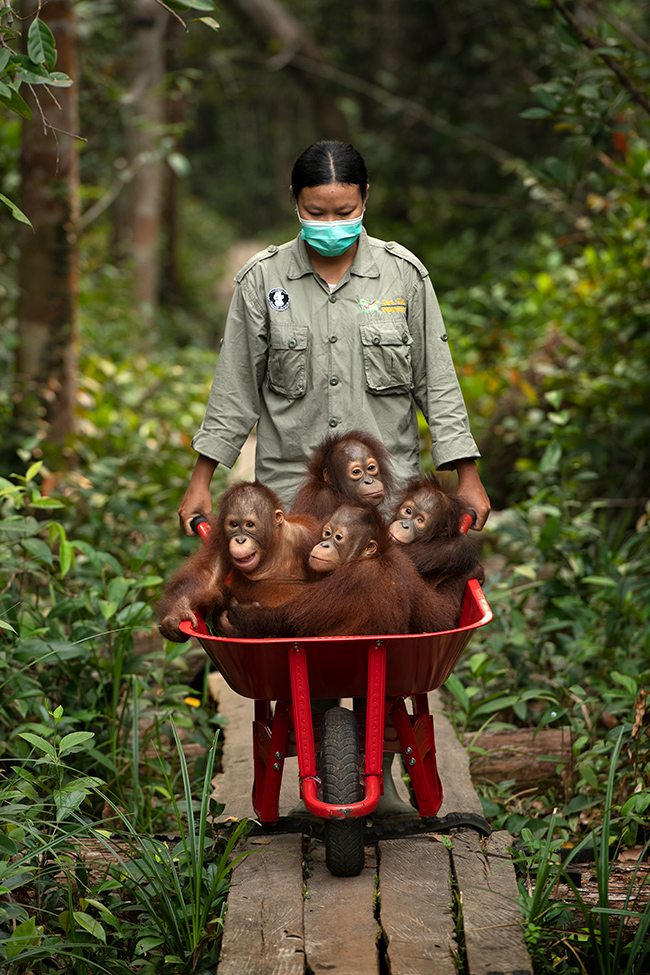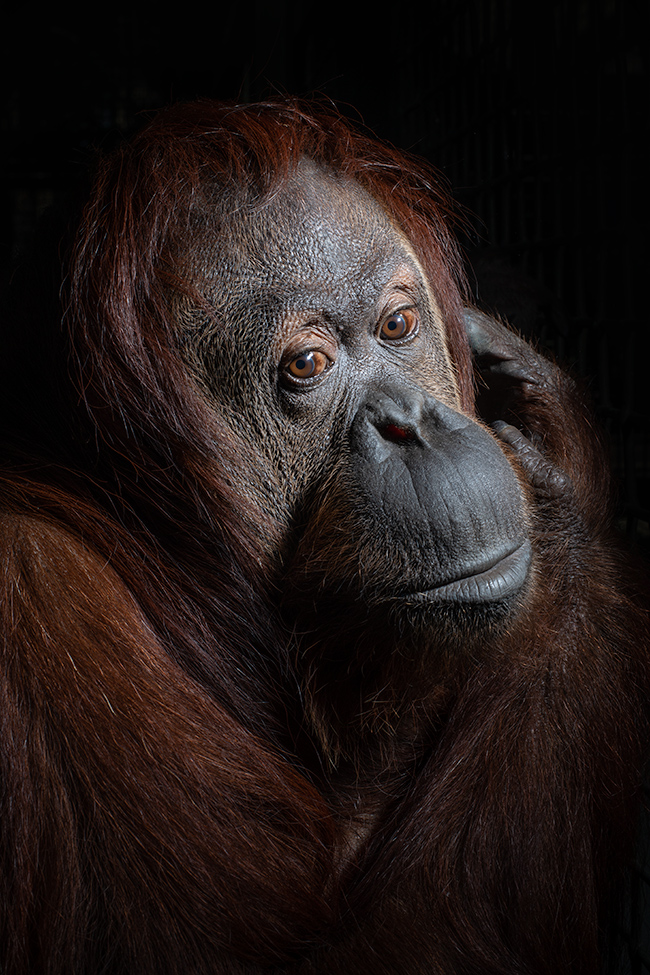One Good Turn: Mark Edward Harris's Stunning Portraits of Surprising Subjects
Christopher, an adult male, at the Center for Great Apes, Wauchula, Florida. D850, AF-S NIKKOR 85mm f/1.8G, 1/250 second, f/8, ISO 100, manual exposure, Matrix metering.
Lucy at the Simon Skjodt International Orangutan Center at the Indianapolis Zoo. "I have no idea why she's doing a Madonna Vogue pose," Mark says. "She must have heard the song or seen the music video. These expressions and poses are often very quick. I have a split second to get the image." D850, AF-S NIKKOR 24-70mm f/2.8G ED, 1/250 second, f/22, ISO 100, manual exposure, Matrix metering.
Ask Mark Edward Harris why he became interested in taking portraits of orangutans and he'll happily tell you the story, which he will preface by saying, "It's so typical of how things happen in life."
Well, okay, that's true, but only up to a point. And that point will stop you in your tracks. Mark's a Los Angeles-based travel and documentary photographer, and back in 2014 he was in Indianapolis, working on a general travel story. His visit happened to coincide with the opening of the Simon Skjodt International Orangutan Center at the Indianapolis Zoo, and he thought he'd take a look and take a few pictures.
"The orangutans would come right up to the glass," he says, "and I'd take pictures—and I know this sounds almost impossible to believe—they would signal for me to turn the camera around. They wanted to see what the photos looked like."
Wait...what?
"They gestured for me to turn the camera around so they could see the results on the LCD. And they'd study the photos—they didn't sign off on them, no thumbs up or down, but they were curious about the pictures. I was blown away."
And so it began.
Katy, at the Indianapolis Zoo. "People always comment that someone is combing her hair," Mark says. "Not so." The combination of small aperture, fast shutter and strobe flash (on a monopod hand-held off-camera at an angle to the glass) overpowers the ambient light and blacks out the background. D850, AF-S NIKKOR 24-70mm f/2.8G ED, 1/200 second, f/22, ISO 100, manual exposure, Matrix metering.
Azy, an adult male at the International Center in Indianapolis, in a portrait that's a favorite of Mark's for its symmetry and projection of personality. "He studied me in a quiet, meditative manner," Mark says. "I link the Azy and Katy shots as companion photos—both looking at the camera, or me, with very strong eye contact. You feel a connection. How real it is, who knows? But you feel it through the glass." D850, AF-S NIKKOR 24-70mm f/2.8G ED, 1/200 second, f/22, ISO 100, manual exposure, Matrix metering.
Learning Curve
Mark knew little to nothing about orangutans. "The stuff I'd done for so many years had a focus on people," he says. But he was fascinated by them, and he learned fast.
"They're self-aware," he says, "and there's no doubt there are sentient beings behind those eyes." He found out that orangutans and humans share about 97 percent of their DNA sequence. "And the word 'orangutan' comes from the Malay and Indonesian words for 'person of the forest,' so when they were first seen it was obvious to the people who interacted with them that they really were like people."
There's more, and Mark was in the right place to learn it: the Center is known for its research into the cognitive abilities of great apes. "After my first meeting with them I was so amazed at what I saw that I asked for permission to come back to take their portraits, and I was given special access."
If there was any doubt, Mark learned on that visit that the orangutans were absolutely camera aware. "They seem to like being photographed; they enjoy the interaction," he says. "But I don't know if they're thinking, 'Hey, I closed my eyes on that one—take another.' I have no clue about that."
He also learned that the primatologist at the Indianapolis Zoo was doing studies with the orangutans that involved, among other things, playing tic-tac-toe and having them identify objects on a screen. "Their cognitive awareness is amazing," Mark says. "They do gift sharing and gift giving with each other, and they consciously remember [gifts given] and will keep it in mind until they get something back."
Binti and Adi at the Singapore Zoo. Two different aspects and attitudes, separated by 28 frames. "Both come down to the incredible close bond between a mother and a child," Mark says. His black fabric backdrop was clamped to a fence behind them, then extended five or six feet across the ground and draped over a tree stump that served as the platform they're sitting on.
"A gesture from the zookeeper indicated where he wanted Binti to sit," Mark says. "Later it was a slight nod of her head that indicated when she wanted to leave, and then the session was over." D850, AF-S NIKKOR 50mm f/1.4G, 1/200 second, f/4 (left), f/4.5 (right), ISO 800, manual exposure, Matrix metering.
For me the magic of still photography is that you can freeze a moment in time. I love frozen moments, decisive moments, so sharpness is so important for me.
Natu and Joko, young male orangutans at the Singapore Zoo. "Natu, on the left, was very shy," Mark says, "but when Joko was brought over, he was much more relaxed. I envisioned much tighter head shots of each one individually, but you go with the flow—and the two together actually made a better picture." D850, AF-S NIKKOR 50mm f/1.4G, 1/160 second, f/4.5, ISO 800, manual exposure, Matrix metering.
Mark photographed Ah Meng, a seven-year-old orphan female, at the Singapore Zoo. He has no idea why she turned, but he quickly took advantage of the profile opportunity. "It wasn't a 'this is my best side' sort of thing," he says. "She might have been curious about something off to the side, or the zookeeper might have been standing there." D850, AF-S NIKKOR 50mm f/1.4G, 1/200 second, f/4.5, ISO 800, manual exposure, Matrix metering.
Habitats, Natural and Otherwise
Indianapolis was the start. After his initial photography there, stories came out, images were published and people concerned with the survival of orangutans realized Mark was a resource.
In January, 2018, the project really picked up. "I'd done some reportage on the cognitive studies," Mark says, "but I realized the portraits were unique—that's something people don't normally have access to, and it was in line with what I like to photograph."
When a friend told him that Singapore had an amazing zoo with orangutans, he reached out. "It took a lot of legwork and paperwork to lay the groundwork for more portraits—you don't just show up and shoot some photos and move on."
But it was worth the effort, as Mark now knew the photos could have a life beyond his initial interest. The only orangutans left in the wild are in the rainforests of Borneo and Sumatra, and their habitats are disappearing as large plantations take over the land. "There are national parks put aside for them," Mark says, "but the orangutans don't know where a park ends and a plantation begins, and if they're looking for food on what once was their land, they can get killed there." The orangutans are also threatened by poachers who take the babies for sale to illegal zoos and roadside shows or as pets.
Mark's images could call attention and rally support, and he dug in, photographing at zoos and rescue centers, giving lectures and talks and exhibiting the portraits.
Chomel and Putra at the Singapore Zoo. "In Singapore I'm in the compound with the orangutans, and I set up my backdrop and lights and the handlers bring the orangutans in one at a time. Nothing separates me from them, and that's why there are no adult males in the Singapore photographs. You can't be in an enclosure with one, it's too dangerous." D850, AF-S NIKKOR 24-70mm f/2.8G ED, 1/250 second, f/16, ISO 100, manual exposure, Matrix metering.
Mark photographed Fani on one of the former pre-release islands at the Borneo Orangutan Survival Foundation Sanctuary at Samboja Lestari, Borneo, Indonesia. "Today these smaller islands are mostly used as sanctuary islands for unreleasable orangutans like Fani," he says. "She probably will never be able to live in the wild—she was too old for the forest school training and had already lived in captivity for too long. But at Samboja Lestari she's able to live in a natural environment." D850, AF-S NIKKOR 500mm f/5.6E PF ED VR, 1/500 second, f/9, ISO 800, manual exposure, Matrix metering.
Ways and Means
Over time he developed a methodology.
At the Center for Great Apes in Wauchula, Florida, he'll be shooting through bars, so he favors the relative slimness of an 85mm or a 50mm prime lens. In Indianapolis, at the Orangutan Center at the zoo, it's a through-the-glass shoot where angles are important to defeat reflections and the lens, most of the time, is his 24-70mm. In the wild at a rescue center or sanctuary, the choices are long and longer lenses: the 70-200mm zoom or the 500mm telephoto.
Mark has special praise for the 500mm, which he got to photograph tigers in India and then brought to Borneo to work with the orangutans in the wild. "Light, small and so tack sharp I can shoot wide open," he says. "For me the magic of still photography is that you can freeze a moment in time. I love frozen moments, decisive moments, so sharpness is so important for me."
For outdoor enclosures he'll most often use a strobe, hand-held, off-camera, at an angle to the glass, in order to overpower daylight and darken the background. Sometimes he'll set up his black cloth background before his portrait subjects were brought in.
He's never used a tripod for the orangutan portraits, indoors or out. "I have to be mobile—quick and decisive. Even if I’m standing still, the orangutans are either moving or liable to move."
"Quick" is the key word. He works fast because he has to. The orangutans aren't camera shy, but they're on their own schedules. "When the session's over, it's over; they get up and go away."
Part of his methodology is knowing that success can be a trap. "If you're getting it right too often, you're doing something wrong," he says. Obstacles, hesitancies, even failures are part of the process, and they tell you you're still learning. "I not only accept that, I embrace it. I'm constantly learning."
It pays off: these are photographs you cannot make without expertise, experience, results and a reputation for working within the regulations and restrictions.
Unidentified young orangutan at the Borneo Orangutan Survival Foundation's Nyaru Menteng Orangutan Rescue Center, Central Kalimantan, Borneo, Indonesia. D850, AF-S NIKKOR 70-200mm f/2.8G ED VR II, 1/160 second, f/5, ISO 800, shutter-priority exposure, Matrix metering.
A surrogate mother transports orphans back to their evening shelter after a day of forest school training at the Nyaru Menteng Orangutan Rescue Center. "At the forest school they learn the survival skills they'll need to survive in the wild," Mark says. "At this stage, they don't make their way to or from the school without this type of transport." D850, AF-S NIKKOR 70-200mm f/2.8G ED VR II, 1/320 second, f/4.5, ISO 400, manual exposure, Matrix metering.
Turn the Camera Around
At the end of the story, we were left with questions no one could answer.
What do the orangutans see? What do we see?
A Nikon manager and photo editor says she saw "expression, emotion, personality." Mark says there's a calmness, a serenity. He also says the orangutans seem often to be studying him as he studies them—sizing him up and checking his work with a gesture that tells him to turn the camera around. "They are studying me as much as I study them," Mark says. "Maybe more."
The orangutans in Indianapolis learned what a camera can do, probably when a visitor, on a whim, maybe with a smile, turned a camera and showed one of them the photo she'd just taken. And now they know.
But of course we're just guessing. Ultimately Mark does this work because at the start, at that first meeting, in Indianapolis, it just felt right, and that was enough for him. As he says, "When you tap into that feeling, when something feels right, you have to run with it for a while."
Sandra, a 33-year-old orangutan who was granted personhood by an Argentine court, now lives at the Center for Great Apes in Wauchula, Florida. Commenting on her ruling, Judge Elena Liberatori said, "I wanted to tell society something new, that animals are sentient beings and that the first right they have is our obligation to respect them." Mark photographed Sandra at the Center. D850, AF-S NIKKOR 50mm f/1.4G, 1/250 second, f/16, ISO 50, manual exposure, Matrix metering.

